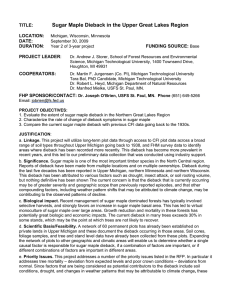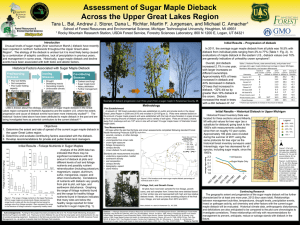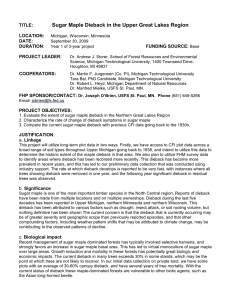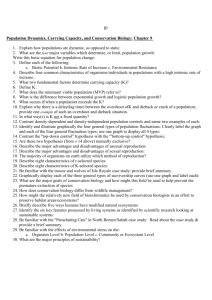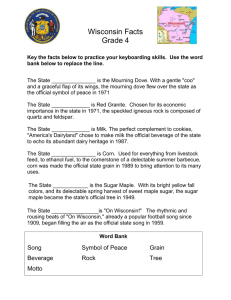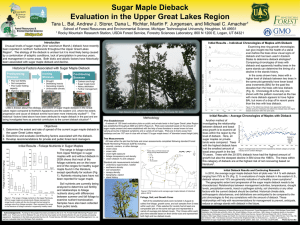Sugar Maple Dieback in the Upper Great Lakes Region TITLE: LOCATION:
advertisement
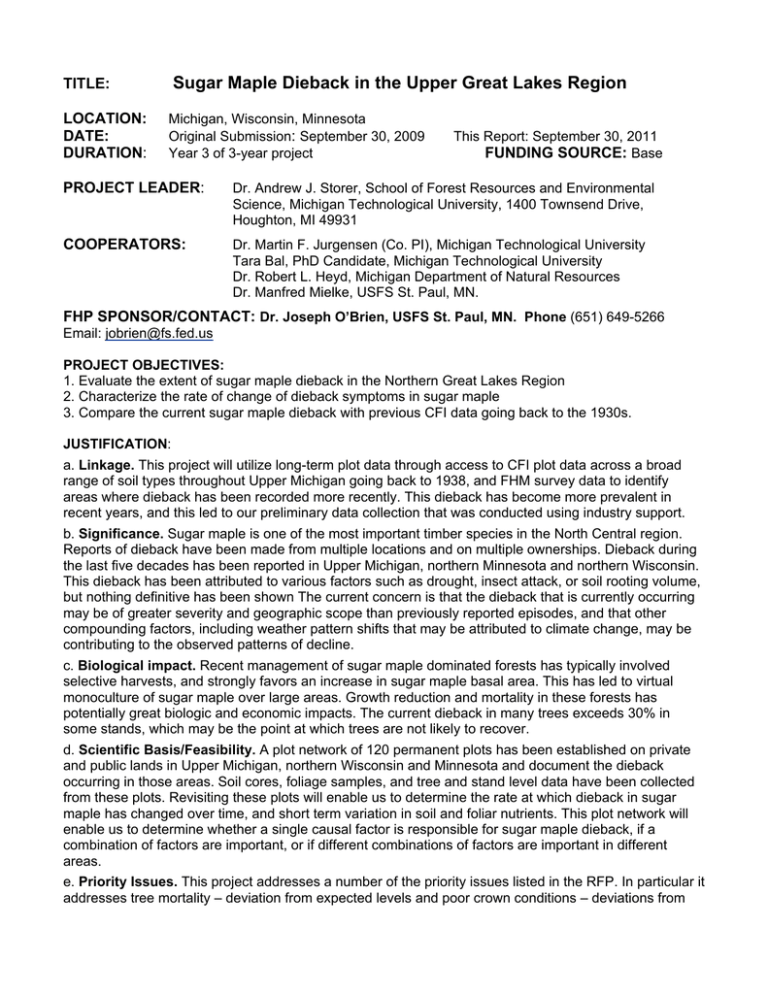
Sugar Maple Dieback in the Upper Great Lakes Region TITLE: LOCATION: DATE: DURATION: Michigan, Wisconsin, Minnesota Original Submission: September 30, 2009 Year 3 of 3-year project This Report: September 30, 2011 FUNDING SOURCE: Base PROJECT LEADER: Dr. Andrew J. Storer, School of Forest Resources and Environmental Science, Michigan Technological University, 1400 Townsend Drive, Houghton, MI 49931 COOPERATORS: Dr. Martin F. Jurgensen (Co. PI), Michigan Technological University Tara Bal, PhD Candidate, Michigan Technological University Dr. Robert L. Heyd, Michigan Department of Natural Resources Dr. Manfred Mielke, USFS St. Paul, MN. FHP SPONSOR/CONTACT: Dr. Joseph O’Brien, USFS St. Paul, MN. Phone (651) 649-5266 Email: jobrien@fs.fed.us PROJECT OBJECTIVES: 1. Evaluate the extent of sugar maple dieback in the Northern Great Lakes Region 2. Characterize the rate of change of dieback symptoms in sugar maple 3. Compare the current sugar maple dieback with previous CFI data going back to the 1930s. JUSTIFICATION: a. Linkage. This project will utilize long-term plot data through access to CFI plot data across a broad range of soil types throughout Upper Michigan going back to 1938, and FHM survey data to identify areas where dieback has been recorded more recently. This dieback has become more prevalent in recent years, and this led to our preliminary data collection that was conducted using industry support. b. Significance. Sugar maple is one of the most important timber species in the North Central region. Reports of dieback have been made from multiple locations and on multiple ownerships. Dieback during the last five decades has been reported in Upper Michigan, northern Minnesota and northern Wisconsin. This dieback has been attributed to various factors such as drought, insect attack, or soil rooting volume, but nothing definitive has been shown The current concern is that the dieback that is currently occurring may be of greater severity and geographic scope than previously reported episodes, and that other compounding factors, including weather pattern shifts that may be attributed to climate change, may be contributing to the observed patterns of decline. c. Biological impact. Recent management of sugar maple dominated forests has typically involved selective harvests, and strongly favors an increase in sugar maple basal area. This has led to virtual monoculture of sugar maple over large areas. Growth reduction and mortality in these forests has potentially great biologic and economic impacts. The current dieback in many trees exceeds 30% in some stands, which may be the point at which trees are not likely to recover. d. Scientific Basis/Feasibility. A plot network of 120 permanent plots has been established on private and public lands in Upper Michigan, northern Wisconsin and Minnesota and document the dieback occurring in those areas. Soil cores, foliage samples, and tree and stand level data have been collected from these plots. Revisiting these plots will enable us to determine the rate at which dieback in sugar maple has changed over time, and short term variation in soil and foliar nutrients. This plot network will enable us to determine whether a single causal factor is responsible for sugar maple dieback, if a combination of factors are important, or if different combinations of factors are important in different areas. e. Priority Issues. This project addresses a number of the priority issues listed in the RFP. In particular it addresses tree mortality – deviation from expected levels and poor crown conditions – deviations from normal. Since factors that are being considered as potential contributors to the dieback include soil conditions, drought, and changes in weather patterns that may be attributable to climate change, these priority issues are also being addressed. DESCRIPTION: a. Background: Major maple mortality events have occurred in pockets in various locations and extents throughout the 20th century. Mortality was attributed to drought, pathogens, past cutting practices pollution and insect defoliation. Recently, unusual levels of dieback of sugar maple have been reported in the western Upper Peninsula of Michigan and other areas in the North Central region. b. Methods: Our work evaluates the condition of maple resources in 120 plots in Upper Michigan, Northern Wisconsin and Minnesota. We will work with National Forest staff and Forest Health Monitoring to identify areas with and without significant levels of dieback, and use historical CFI data to identify where dieback has been documented in the past. Description of the plots establishment is found in the progress report section below. c. Products: We anticipate completing peer-reviewed papers describing our findings, and developing guidelines for management of sugar maple in areas where dieback is present. In addition, we will contribute poster and oral presentations at meetings attended by stake-holders, including the annual Forest Health Working Group Meeting or other designated venue for sharing our progress and findings. d. Schedule of Activities (Year 3): Fall/Winter 2011-12 Complete processing of soil and foliage samples. Initial data analysis to identify data gaps that can be filled in Summer 2012. Spring/Summer 2012 Revisit plots for canopy assessments and change in dieback and to collect data to fill data gaps (e.g. additional soil and foliage samples as needed) Fall/Winter 2012-2013 Processing of 2012 foliage and soil samples Complete analysis of data and prepare manuscripts. e. Progress/Accomplishments: The network of sixty additional plots has been established, predominantly on forest service land. These plots are in addition to the 60 previously established on industry land. During the summer of 2011, the 60 new, 1/10th acre plots were revisited in sugar maple forests on federal, state, and private lands. Data Collection Methods Each tree in a 1/10 acre plot was measured and underwent a full canopy assessment in 2011. Understory and regeneration subplots were included within the plot. Biotic factors impacting the vigor of trees were assessed, including sugar maple borer, cankers, sap streak disease, and wounds. Further plot characteristics recorded included skid trail and forest soil penetrometer readings, canopy density measurements and earthworm activity. In 2010, foliage samples were collected in August in a subset of 30 plots from trees with high, intermediate and low dieback for nutrient analysis. On these same 30 plots, soil samples were collected by horizon from beneath healthy and dieback trees, and for analysis of carbon content, total nitrogen, available cations, and pH and texture. These samples were analyzed in 2011. In addition, soil and foliar samples were collected in 2011 from the 30 plots that were not sampled in 2010 and are currently being prepared for submission for analysis. This sampling supplements that carried out on the 60 plots on industry land that are part of the plot network. Hence we will have foliar and soil analyses for all 120 plots in the network. Tree cores were taken from the same trees as foliage and soils were collected from, and are processed on a growth-ring analyzer to calculate the effect of dieback on tree radial growth. Initial Results The data collected in 2010 and 2011 show that the amount of dieback has apparently increased in these plots (Table 1). For example, in the plots on the Ottawa national forests, mean dieback increased from 12.6% to 21.2% from 2010 to 2011. In addition, we have received the results of foliar nutrient analyses for some of the plots sampled in 2010. These suggest that there are some imbalances in certain nutrients compared with published normal levels (Figure 1). Table 1: Dieback of sugar maple in various groupings of research plots from 2009-2011. Ownership Total # of plots revisited 2011 2009 Leaf-On Dieback % 2010 Leaf-On Dieback % 2011 Leaf-On Dieback % Superior N.F. 6 18.1 Chequamegnon N.F. 8 11.1 Nicolet N.F. 8 13.9 Hiawatha N.F. 5 11.5 Ottawa N.F. 23 12.6 MI State-DNRE 5 9.3 MI State-MTU 2 6.4 Other Private CFA Land 1 12.3 Private Industry Land 60 18.7 16.3 18.7 14.4 Overall Average * Negative sign represents an increase in the amount of dieback. 26.2 15.8 18.4 15.2 21.2 11.4 4.7 15.0 20.8 16.5 Change in 2010-2011 Dieback* -8.1 -4.7 -4.5 -3.7 -8.6 -2.1 1.7 -2.6 -4.5 -2.1 Figure 1. The ranges of selected foliage nutrient levels found in the western Upper Peninsula (box plots). The line through the center of the box is average foliage level found and bars represent the range found in healthy sugar maple in literature. Information is also available for Fe, Zn, B, Al, Pb, Cu, Cr, Cd, Ni. Historical Forest Inventory Data was located for three sections in Baraga County, MI with plot values for tree vigor going back to as early as the 1930’s with measurements collected since then on roughly 10 year cycles. Approximately 180 plots were revisited during the summer of 2011 using the same protocols for tree vigor as the historical Forest Inventory surveyors used. These data are currently being analyzed and will be used to determine if/how sugar maple vigor in the plots has changed over the last 6 to 7 decades. If any patterns of change are evident or correlated with climate, management, or defoliation outbreaks, this longer term data will be useful for developing management plans for sugar maple in northern hardwood forests. COSTS: Item Personnel and fringes Supplies Travel Services Overhead (10%) Total Year 1 FHM 40,563 2000 5982 6000 5,455 60,000 Year 1 MTU 9,269 29,643 38,912 Year 2 FHM 40,545 2000 5982 6000 5,455 60,000 Year 2 MTU 8,986 23,999 37,837 Year 3 FHM 40,545 2000 5982 6000 5,455 60,000 Year 3 MTU 8,986 28,851 37,837 Personnel: 1 PhD student, faculty summer support and undergraduate field assistants. Supplies include those for the fieldwork and sampling. Services include soil and foliage analysis. Travel covers travel to field sites and travel to the annual FMH Work Group Meeting. More than 50% of the work described in this proposal takes place on federal land, and hence the costshare proposed is less than 1:1.
